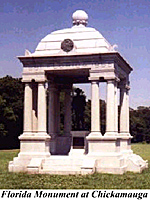 Florida Monument at Chickamauga
Florida Monument at Chickamauga
Chickamauga was one of the biggest and most ferocious battles in the West, and was fought over two days in September 1863. Further, it was a rare win for the Confederacy, and a potentially decisive victory at that, had Braxton Bragg elected to pursue the beaten Army of the Cumberland instead of besieging it in Chattanooga. As such, its battlefield is worthy of preservation in large and elaborate form.
Justice is served. Chickamauga is on a par with Gettysburg when it comes to size. Surprisingly, it is also comparable to the Pennsylvania battlefield in its monuments as well. Like it, there is a plethora of memorials to leaders and units, and the states from which they hailed. There are others with heavy concentrations of marble; Antietam stands out, and even Kennesaw Mountain, Georgia has its share. Chickamauga further follows Gettysburg's lead in memorializing the positions of units during the battle with small stone markers. One can pace the frontage of regiments as the stood during the most crucial stages, and look over to monuments erected to the enemies with whom they crossed bayonets. In the end,
Chickamauga's monuments constitute both a tour de force of public sculpture, and a solid record of the battle's progress.
Much of the credit for that belongs to two veterans of the Army of the Cumberland, H.V. Boynton and Ferdinand Van Derveer. Returning to Chickamauga in 1888, they saw the need for a park to commemorate the battle. Not only did they become the prime movers for the park, spending two years garnering political support for the park, they planned the placement of most of the fourteen hundred monuments and markers there. I have yet to meet a Civil War battlefield with a truly unappealing setting. True, Bull Run is on the edge of a suburban asphalt morass, but once on the battlefield itself one finds an historical haven from the environment beyond. Antietam has long been my favorite, being separated by distance, time and atmosphere from the major cities of the East.
As for the Gettysburg, its millieu is of a beautiful rural area and small town, all the more attractive for the destruction of the "National Tower" eyesore, but beset with some of the largest crowds in the National Park Service's collection of battlefield sites.
Chickamauga combines the feel of Gettysburg with the natural beauty of Antietam, but without the overcrowding of the former. Just as Antietam is a convenient distance from the sprawling Washington DC area, so Chickamauga is just close enough from Atlanta to permit visitors, but sufficiently distant to keep the hordes out.
Terrain-wise, it is flat for the most past, but more wooded than cultivated, similar to Chancellorsville and the other battlefields of the Wilderness-Fredericksburg area. If anything it is the trees that define the battlefield, more than any dominating height or watercourse.
The visitor's center, quite new and well-appointed, houses one of the great unpublicized treasures of Chickamauga, the Fuller Collection of American Firearms. For the gun enthusiast, the experience can be a little like dying and going to heaven, or at least some gunpowder-obsessed branch of the Royal Armouries. It is not the number of guns that impresses; Gettysburg's collection of Civil War weapons is far larger. It is the quality, and the high incidence of rarities.
The oldest item in the Fuller Collection, most probably, is a late renaissance-era matchlock arquebus. The collection really takes up the firearms story in the eighteenth century, the era of the Brown Bess musket and Ferguson rifle, and carries it to the twentieth.
More Bragg's Victory, Bragg's Defeat
Back to Cry Havoc #33 Table of Contents
Back to Cry Havoc List of Issues
Back to MagWeb Master Magazine List
© Copyright 2001 by David W. Tschanz.
This article appears in MagWeb (Magazine Web) on the Internet World Wide Web. Other military history articles and gaming articles are available at http://www.magweb.com